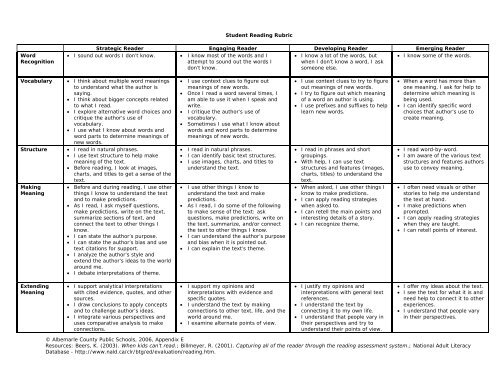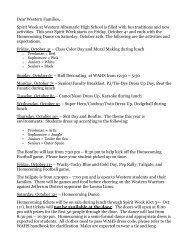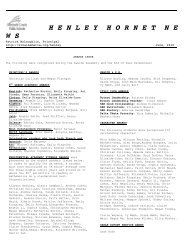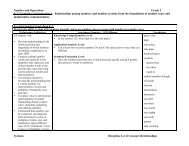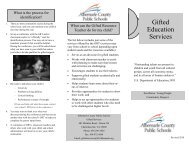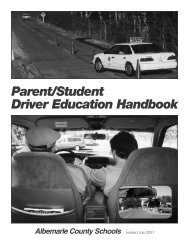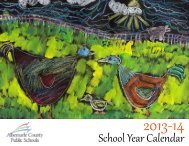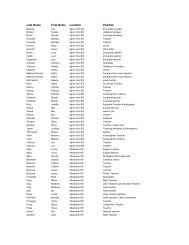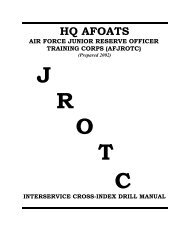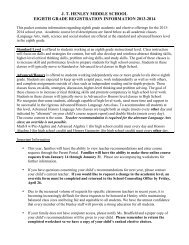Language Arts/English Curriculum Frameworks - Albemarle County ...
Language Arts/English Curriculum Frameworks - Albemarle County ...
Language Arts/English Curriculum Frameworks - Albemarle County ...
Create successful ePaper yourself
Turn your PDF publications into a flip-book with our unique Google optimized e-Paper software.
Student Reading Rubric<br />
Word<br />
Recognition<br />
Strategic Reader Engaging Reader Developing Reader Emerging Reader<br />
• I sound out words I don’t know. • I know most of the words and I<br />
• I know a lot of the words, but • I know some of the words.<br />
attempt to sound out the words I<br />
when I don’t know a word, I ask<br />
don’t know.<br />
someone else.<br />
Vocabulary<br />
• I think about multiple word meanings<br />
to understand what the author is<br />
saying.<br />
• I think about bigger concepts related<br />
to what I read.<br />
• I explore alternative word choices and<br />
critique the author’s use of<br />
vocabulary.<br />
• I use what I know about words and<br />
word parts to determine meanings of<br />
new words.<br />
• I read in natural phrases.<br />
• I use text structure to help make<br />
meaning of the text.<br />
• Before reading, I look at images,<br />
charts, and titles to get a sense of the<br />
text.<br />
• Before and during reading, I use other<br />
things I know to understand the text<br />
and to make predictions.<br />
• As I read, I ask myself questions,<br />
make predictions, write on the text,<br />
summarize sections of text, and<br />
connect the text to other things I<br />
know.<br />
• I can state the author’s purpose.<br />
• I can state the author’s bias and use<br />
text citations for support.<br />
• I analyze the author’s style and<br />
extend the author’s ideas to the world<br />
around me.<br />
• I debate interpretations of theme.<br />
• I use context clues to figure out<br />
meanings of new words.<br />
• Once I read a word several times, I<br />
am able to use it when I speak and<br />
write.<br />
• I critique the author’s use of<br />
vocabulary.<br />
• Sometimes I use what I know about<br />
words and word parts to determine<br />
meanings of new words.<br />
• I use context clues to try to figure<br />
out meanings of new words.<br />
• I try to figure out which meaning<br />
of a word an author is using.<br />
• I use prefixes and suffixes to help<br />
learn new words.<br />
• When a word has more than<br />
one meaning, I ask for help to<br />
determine which meaning is<br />
being used.<br />
• I can identify specific word<br />
choices that author’s use to<br />
create meaning.<br />
Structure<br />
• I read in natural phrases.<br />
• I can identify basic text structures.<br />
• I use images, charts, and titles to<br />
understand the text.<br />
• I read in phrases and short<br />
groupings.<br />
• With help, I can use text<br />
structures and features (images,<br />
charts, titles) to understand the<br />
text.<br />
• When asked, I use other things I<br />
know to make predictions.<br />
• I can apply reading strategies<br />
when asked to.<br />
• I can retell the main points and<br />
interesting details of a story.<br />
• I can recognize theme.<br />
• I read word-by-word.<br />
• I am aware of the various text<br />
structures and features authors<br />
use to convey meaning.<br />
Making<br />
Meaning<br />
• I use other things I know to<br />
understand the text and make<br />
predictions.<br />
• As I read, I do some of the following<br />
to make sense of the text: ask<br />
questions, make predictions, write on<br />
the text, summarize, and/or connect<br />
the text to other things I know.<br />
• I can understand the author’s purpose<br />
and bias when it is pointed out.<br />
• I can explain the text’s theme.<br />
• I often need visuals or other<br />
stories to help me understand<br />
the text at hand.<br />
• I make predictions when<br />
prompted.<br />
• I can apply reading strategies<br />
when they are taught.<br />
• I can retell points of interest.<br />
Extending<br />
Meaning<br />
• I support analytical interpretations<br />
with cited evidence, quotes, and other<br />
sources.<br />
• I draw conclusions to apply concepts<br />
and to challenge author’s ideas.<br />
• I integrate various perspectives and<br />
uses comparative analysis to make<br />
connections.<br />
• I support my opinions and<br />
interpretations with evidence and<br />
specific quotes.<br />
• I understand the text by making<br />
connections to other text, life, and the<br />
world around me.<br />
• I examine alternate points of view.<br />
• I justify my opinions and<br />
interpretations with general text<br />
references.<br />
• I understand the text by<br />
connecting it to my own life.<br />
• I understand that people vary in<br />
their perspectives and try to<br />
understand their points of view.<br />
• I offer my ideas about the text.<br />
• I see the text for what it is and<br />
need help to connect it to other<br />
experiences.<br />
• I understand that people vary<br />
in their perspectives.<br />
© <strong>Albemarle</strong> <strong>County</strong> Public Schools, 2006, Appendix E<br />
Resources: Beers, K. (2003). When kids can’t read.; Billmeyer, R. (2001). Capturing all of the reader through the reading assessment system.; National Adult Literacy<br />
Database - http://www.nald.ca/clr/btg/ed/evaluation/reading.htm.


